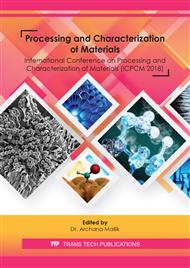[1]
K. Siva, N.Murugan, V. Raghupathy, Modelling, analysis and optimization of weld bead parameters of nickel based overlay deposited by plasma transferred arc surfacing, Archives of Computational Materials Science and Surface Engineering.1(2009)174–182.
Google Scholar
[2]
K. Shiva, N. Murugan, and R. Logesh, Optimization of weld bead geometry in plasma transferred arc hardfaced austenitic stainless steel plates using genetic algorithm. International Journal of Advanced Manufacturing Technology. 41(2009) 24–30.
DOI: 10.1007/s00170-008-1451-3
Google Scholar
[3]
V. Gunaraj and N.Murugan, Application of response surface methodology for predicting weld bead quality in submerged arc welding of pipes. Journal of Material Processing Technology. 88 (1999) 266–275.
DOI: 10.1016/s0924-0136(98)00405-1
Google Scholar
[4]
E. L. Rayes,W. C., and S. G., The influence of various hybrid welding parameters on bead geometry, Welding Journal. 83(2004) 147–153.
Google Scholar
[5]
P. Harris and B. L. Smith, Factorial technique for weld quality prediction, Metal Construction, 15(1983) 661–666.
Google Scholar
[6]
A. Gatto, E. Bassoli, and M. Fornari, Plasma transferred arc deposition of powdered high performances alloys: process parameters optimisation as a function of alloy and geometrical configuration, Surface and Coatings Technology. 187(2004) 265 – 271.
DOI: 10.1016/j.surfcoat.2004.02.013
Google Scholar
[7]
P. Reinaldo and A. D'Oliveira, Nicrsib coatings deposited by plasma transferred arc on different steel substrates, Journal of Materials Engineering and Performance. 22(2013) 590–597.
DOI: 10.1007/s11665-012-0271-7
Google Scholar
[8]
S. Ozel, B. Kurt, I. Somunkiran, and N. Orhan, Microstructural characteristic of niti coating on stainless steel by plasma transferred arc process, Surface and Coatings Technology. 202(2008) 3633 – 3637.
DOI: 10.1016/j.surfcoat.2008.01.006
Google Scholar
[9]
F. Fernandes, B. Lopes, A. Cavaleiro, A. Ramalho, and A.Loureiro, Effect of arc current on microstructure and wear characteristics of a ni-based coating deposited by PTA on gray cast iron, Surface and Coatings Technology. 205(2011) 4094 – 4106.
DOI: 10.1016/j.surfcoat.2011.03.008
Google Scholar
[10]
A. Lakshminarayanan, V. Balasubramanian, R. Varahamoorthy, and S. Babu, Predicting the dilution of plasma transferred arc hardfacing of stellite on carbon steel using response surface methodology, Metals and Materials International. 14(2008) 779–789.
DOI: 10.3365/met.mat.2008.12.779
Google Scholar
[11]
A. Barroi, J. Hermsdorf, U. Prank, and S. Kaierle, A novel approach for high deposition rate cladding with minimal dilution with an arc laser process combination, Physics Procedia. 41(2013) 249 – 254.
DOI: 10.1016/j.phpro.2013.03.076
Google Scholar
[12]
J. A. Robert Jayachandran and N. Murugan, Investigations on the influence of surfacing process parameters over bead properties during stainless steel cladding, Materials and Manufacturing Processes. 27(2012) 69–77.
DOI: 10.1080/10426914.2011.552019
Google Scholar
[13]
W. Xibao, W. Xiaofeng, and S. Zhongquan, The composite fe-ti-b-c coatings by PTA powder surfacing process, Surface and Coatings Technology. 192(2005) 257 – 262.
DOI: 10.1016/j.surfcoat.2004.08.210
Google Scholar
[14]
C. Sudha, P. Shankar, R. S. Rao, R. Thirumurugesan,M. Vijayalakshmi, and B. Raj, Microchemical and microstructural studies in a PTA weld overlay of ni-cr-si-b alloy on AISI 304l stainless steel, Surface and Coatings Technology. 202(2008) 2103 – 2112.
DOI: 10.1016/j.surfcoat.2007.08.063
Google Scholar
[15]
H. Kumar, S. Albert, C. Sudha, R. Vijayashree, A. Bhaduri, and C. Balasubramanian, Hardfacing of a modified 9cr-1mo steel component using a nickel-base alloy, Transactions of the Indian Institute of Metals. 64(2011) 339–343.
DOI: 10.1007/s12666-011-0087-4
Google Scholar
[16]
S. Mandal, S. Kumar, P. Bhargava, C. H. Premsingh, C. P. Paul and L. M. Kukreja, An analysis on bead characteristics in material deposition by PTAW process, Applied Mechanics and Materials. 592-594 (2014) 33 – 37.
DOI: 10.4028/www.scientific.net/amm.592-594.33
Google Scholar


